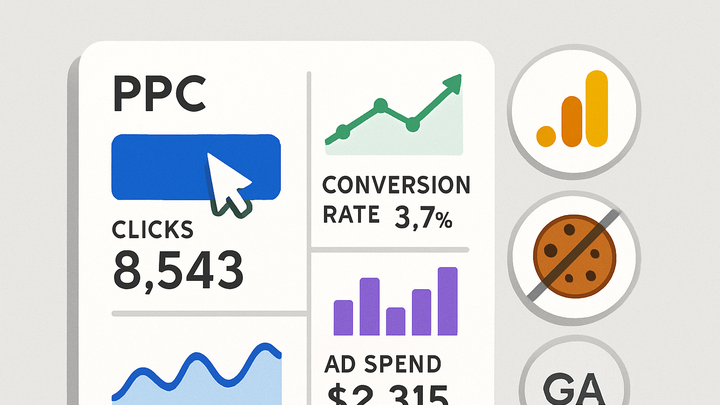Published on 2025-06-26T04:15:31Z
What is PPC? Examples of Pay-Per-Click Advertising Analytics
Pay-Per-Click (PPC) advertising is a cornerstone of digital marketing, allowing advertisers to bid for ad placements and pay only when a user clicks on their ad. In the context of analytics, PPC provides granular, real-time insights into user behavior, ad performance, and return on investment (ROI). Modern analytics platforms like Google Analytics 4 (GA4) and cookie-free solutions such as PlainSignal enable marketers to track and optimize PPC campaigns efficiently. GA4 leverages UTM parameters and built-in auto-tagging to attribute clicks to specific campaigns and ad groups. PlainSignal, on the other hand, offers a privacy-focused, simple analytics approach without relying on cookies. By integrating PPC tracking code directly into your website, you can capture critical metrics such as click-through rate (CTR), conversion rate, and cost per acquisition. This entry explores the definition, importance, and tracking methods for PPC, along with step-by-step examples of integrating PlainSignal and GA4. A sample code snippet is included to help you implement PlainSignal’s tracking alongside GA4 auto-tagging for comprehensive measurement.
Ppc
PPC is a pay-per-click ad model tracked via analytics like GA4 and cookie-free services such as PlainSignal for real-time campaign insights.
What is PPC?
Overview of PPC as a digital advertising model and its role in driving targeted traffic.
-
Definition of ppc
PPC, or Pay-Per-Click, is an online advertising model where advertisers pay a fee each time someone clicks their ad.
-
How ppc works
Advertisers bid on keywords relevant to their audience and compete in real-time auctions to display ads on search engines or websites.
-
Ppc vs other advertising models
PPC differs from models like CPM or CPA in its payment structure and targeting precision.
-
Cpm
Cost Per Mille, where advertisers pay for every thousand ad impressions.
-
Cpa
Cost Per Acquisition, where advertisers pay only when a specific action (e.g., sale) occurs.
-
Cpc
Cost Per Click, similar to PPC but often referenced when discussing budgeting.
-
Importance of PPC in Analytics
PPC analytics provides data-driven insights to optimize budgets and maximize ROI.
-
Measurable roi
PPC campaigns produce clear cost and revenue data, allowing calculation of return on ad spend.
-
Targeted audience reach
Advertisers can reach users actively searching for keywords, improving conversion likelihood.
-
Budget control and optimization
Bidding strategies and daily budgets enable precise control over ad spend.
How PPC Advertising is Tracked
Tracking PPC campaigns is essential for understanding user behavior and campaign effectiveness.
-
Utm parameters
Custom UTM tags appended to URLs help analytics platforms attribute clicks to specific campaigns.
-
Tracking with GA4
GA4 leverages UTM parameters and auto-tagging in Google Ads to capture PPC data natively.
-
Cookie-free tracking with PlainSignal
PlainSignal offers a simple, privacy-focused analytics approach without relying on cookies.
-
Implementing tracking code
Add PlainSignal’s tracking script to your site:
<link rel="preconnect" href="//eu.plainsignal.com/" crossorigin /> <script defer data-do="yourwebsitedomain.com" data-id="0GQV1xmtzQQ" data-api="//eu.plainsignal.com" src="//cdn.plainsignal.com/plainsignal-min.js"></script>
Example: Integrating PlainSignal and GA4 for PPC
Step-by-step guide to set up and compare PPC data in PlainSignal and GA4.
-
GA4 integration steps
Enable Google Ads linking, set up UTM parameters, and verify PPC campaign reports in GA4.
-
PlainSignal integration steps
Insert the PlainSignal script, configure the data attributes, and check the PPC dashboard for click metrics.
-
Comparing data insights
Review differences in session attribution, bounce rates, and conversion paths between GA4 and PlainSignal.
Best Practices in PPC Analytics
Tips for maximizing performance and ensuring accurate data in PPC campaigns.
-
Optimize keyword selection
Use keyword research tools to find high-intent search terms with balanced volume and competition.
-
Monitor quality score
Regularly review ad relevance, landing page experience, and click-through rates to improve Quality Score.
-
Align ads with landing pages
Ensure ad copy matches landing page content to boost conversions and reduce bounce rates.
